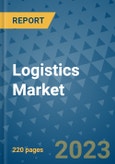According to a report by the analyst, the global logistics market has thrived over the years due to its integral role in globalization. As trade methods and goods movement continue to evolve with technological advancements, the logistics market has experienced consistent growth. The emergence of the e-commerce industry, supported by last-mile delivery solutions, has provided a fresh impetus to the global logistics market in recent years. The increasing number of online shoppers, coupled with improved internet connectivity and higher bandwidths, is expected to further boost the e-commerce industry, creating significant opportunities for the global logistics market from 2021 to 2025.
Globalization with E-commerce Strengthens Opportunities for the Global Logistics Market
The e-commerce industry, driven by online retailing, has become the new norm, especially during the COVID-19 pandemic, which has resulted in prolonged lockdowns. In response to the pandemic, the global logistics market has risen to the challenge by providing solutions for delivering essential and non-essential items to end-users. Logistics players have excelled in offering excellent last-mile delivery solutions to e-commerce platforms, spanning various sectors such as FMCG and entertainment. For instance, Nike rerouted its stocked goods to e-commerce centers to maintain sales during the early stages of the pandemic in 2020. The logistics market has shown exceptional agility in marketing strategies and investments in e-tailing, leading to its growth in the past year.
Risk Assessment and Resilient Solutions Help the Global Logistics Market Cope
The COVID-19 pandemic highlighted the vulnerability of the global logistics market, as it initially struck Wuhan, China, the epicenter of the outbreak. With China being a key manufacturing hub, logistics backlogs accumulated at ports and borders. In March 2020, air freight volumes in China dropped by 19% as passenger flights, which carry cargo, decreased, according to the International Finance Corporation. However, quick risk assessment and implementation of resilient solutions have helped the global market cope exceptionally well. Logistics companies have swiftly implemented new safety protocols, explored alternative modes of transport, and adapted to changing demands. The use of charter flights for air freight and robots for no-contact delivery have emerged as game-changing solutions for the market.
Digitization Transforms the Business Landscape for the Global Logistics Market
The introduction of Internet of Things (IoT), improved tracking mechanisms, and unmanned vehicles for deliveries have been pivotal developments for the global logistics market. Access to real-time information about goods throughout the supply chain has brought significant transparency. Real-time tracking has provided logistics providers with increased visibility, while customers benefit from greater clarity. Analysts anticipate that these developments will play a critical role in the efficient distribution of vaccines in the coming months.
Asia Pacific Emerges as the Leading Market with Growing Online Shoppers
Geographically, the Asia Pacific region is expected to hold a significant share in the global logistics market by the end of 2025. This leap can be attributed to the region's thriving e-commerce industry. The steady growth of online shopping, increasing disposable incomes among millennials and Generation Z, and the development of efficient transportation mechanisms within developing countries have all contributed to the remarkable growth of the logistics market in Asia Pacific.
Players Focus on Delivery Robots to Strengthen their Position
According to the analyst, industry players are expected to focus on no-contact delivery solutions as COVID-19 sets a new trend. Amazon Robotics, for example, is already conducting experiments with Kiva Systems, which aid in packaging and transportation.
Some of the key players studied in the global logistics market research report include DB Schenker Logistics, C.H. Robinson Worldwide, Americold Logistics, DSV A/S, DHL Supply Chain, Expeditors International of Washington, FedEx, J.B. Hunt Transport Services, Ceva Holdings, Kuehne + Nagel, Penske Logistics, SNCF Logistics, Ryder Supply Chain Solutions, United Parcel Service, The Boeing Company, and XPO Logistics, among others.
The global logistics market continues to gain momentum, driven by globalization and the growth of the e-commerce industry. It presents significant opportunities for industry participants, investors, and professionals aiming to capitalize on the evolving dynamics of the logistics sector.
Table of Contents
Companies Mentioned
- J.B. Hunt Transport, Inc.
- C.H. Robinson Worldwide, Inc.
- CEVA Logistics
- FedEx
- XPO Logistics, Inc.
- KENCO
- Deutsche Post AG








